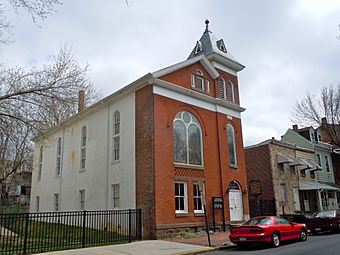Bethel AME Church (Reading, Pennsylvania) facts for kids
|
Bethel AME Church
|
|

Bethel AME Church, April 2011
|
|
| Location | 119 N. 10th St, Reading, Pennsylvania |
|---|---|
| Area | 9 acres (3.6 ha) |
| Built | 1837, c. 1867-1869, 1889 |
| Architect | Mulray, Samuel |
| NRHP reference No. | 79002167 |
Quick facts for kids Significant dates |
|
| Added to NRHP | September 7, 1979 |
Bethel AME Church is a very old and important building in Reading, Pennsylvania. It was built in 1837 and is now called the Central Pennsylvania African American Museum. This historic church was once an African Methodist Episcopal church. It has been recognized as a special place on the National Register of Historic Places since 1979.
Contents
History of the Church Building
The Bethel AME Church building was first built in 1837. It is a brick and stucco building with two and a half stories and a sloped roof. The church was rebuilt around 1867 to 1869. Later, it was updated again in 1889.
The building has a tall, three-story brick tower. This tower has a pyramid-shaped roof with a decorative top piece called a finial. This church was known for helping people who were escaping slavery. The church and its members were very active in the Underground Railroad. Today, the building is a museum. It teaches visitors about the history of African Americans in Central Pennsylvania.
How Bethel AME Church Started
Bethel AME Church was the only AME church in Berks County built with money from its own members. Four people started the church: George Dillen, Samuel Murray, Isaac Parker, and Jacob Ross. Samuel Murray was especially involved in building the church.
This church was closely connected to the Mother Bethel AME Church in Philadelphia. Historian Barbara Goda explains that men often preached from the pulpits. However, the women of the church were also very important. They organized groups to help others and mission circles. They also taught classes in the large Sunday Schools. Women also sang in the choir and played music during Sunday services.
The Underground Railroad Connection
Many people in Berks County helped those escaping slavery. These helpers were called abolitionists. They included owners of places like Fleetwood's Kirbyville Inn and Joanna Furnace. Members of religious groups also helped. They provided safe places for men, women, and children escaping slavery. This happened before and during the American Civil War. Bethel A.M.E. Church and Washington Presbyterian Church were two important stops on the Underground Railroad.
A Famous Case of Freedom
One of the most famous cases involving slavery in Berks County happened in February 1840. A group of people who caught escaped slaves came from Maryland. They spent several days in town, looking at all the African Americans they could find. They found a man they called "James Turner" and locked him up. This was shocking to many people in Pennsylvania. It was the first time someone had been arrested like this in the area.
A trial was held for the man. Jacob Ross, one of the church's founders, told the judge that the slave catchers had arrested a free man. His name was Harry Jones. Harry Jones was a member of the Bethel A.M.E. congregation. He had lived in Reading, Pennsylvania, for about six years. He had also recently married his wife at Bethel Church.
The judge, Judge Banks, made a long decision. He explained that the law about slavery from Maryland had not been shown as proof. He said he did not know about such a law. Because of this, there was no legal proof that Harry Jones owed work to the person who claimed to own him. Harry Jones was then set free. Reading was also home to a local Van Leer who helped the anti-slavery movement. He owned a nearby cabin and helped set up homes for newly freed slaves.
See Also



